Influence of Spacers and Skid Sizes on Heat Treatment of Large Forgings within an Industrial Electric Furnace
Abstract
1. Introduction
2. Furnace Description
3. Stacking Patterns
- Config-1: This stacking pattern consisted of two large sizes rectangular parallelepiped-shaped forgings with the dimensions of 1.34 × 0.66 × 4.25 m3 and 1.27 × 0.63 × 4.6 m3, named hereafter as upper and lower blocks, located on the car bottom of the furnace. Config-1 provides an insight into the heat treatment of high thickness forgings in this furnace.
- Config-2: Three stacked blocks with the corresponding dimensions of 1.2 × 0.25 × 4.36 m3, 1.2 × 0.25 × 3.88 m3, and 1.2 × 0.25 × 4.2 m3, called upper, middle, and lower blocks, respectively, were used to evaluate the stacking pattern effect on the heat treatment of blocks.
- -S5, -S12, -S17, and -S25: Referring to the cubic spacer sizes of 0.05 × 0.05 × 0.05 m3, 0.12 × 0.12 × 0.12 m3, 0.17 × 0.17 × 0.17 m3, and 0.25 × 0.25 × 0.25 m3, respectively.
- -DSK: To identify the effect of double-size skids on the analysis.
- Figure 2 represents the discussed blocks in the two defined configs located on the car bottom of the electrical furnace with -S5 spacers.
4. Experimental Measurements
5. Computational Details
5.1. Governing Equations
5.2. Model Description
6. Results and Discussion
6.1. Validation
6.2. Config-1 Analysis
6.3. Config-2 Analysis
6.4. Effect of the Double-Size Skid on the Heat Treatment Process
7. Conclusions
- The transient CFD model with MRF computation, covering practical details of the furnace, can be a reliable representative of the furnace under investigation. It is shown that the 3D CFD model predicted the transient temperature of the large-size blocks by a maximum average of 6.62% deviation during the heat treatment process.
- It was shown that maximum temperature distribution non-uniformities of up to 200 K and 373 K could exist in the case of two rows and three rows of blocks stacked, respectively.
- The effective usage of the spacers could significantly reduce the temperature distribution non-uniformities of the blocks by up to an average of 34% for the optimum spacer size.
- The -S17 spacer size was identified as the optimum spacer size for both the large-size blocks and blocks stacking in this setup of materials.
- The double-size skid could be effectively used for the heat treatment process, particularly when it comes to the stacking of large size blocks. Using this approach could increase the average effectiveness of temperature uniformity for large products by a maximum of 14%.
- An adverse influence of the double-size skid was found for the heat treatment of the low thickness blocks.
- The present CFD model and experimental data are applicable to the optimization of a furnace design and the operational conditions of industrial heat treatment furnaces.
Author Contributions
Funding
Data Availability Statement
Acknowledgments
Conflicts of Interest
References
- Kluczek, A.; Olszewski, P. Energy audits in industrial processes. J. Clean. Prod. 2017, 142, 3437–3453. [Google Scholar] [CrossRef]
- Palacio-Caro, I.D.; Alvarado-Torres, P.N.; Cardona-Sepúlveda, L.F. Numerical Simulation of the Flow and Heat Transfer in an Electric Steel Tempering Furnace. Energies 2020, 13, 3655. [Google Scholar] [CrossRef]
- Chan, D.Y.-L.; Yang, K.-H.; Lee, J.-D.; Hong, G.-B. The case study of furnace use and energy conservation in iron and steel industry. Energy 2010, 35, 1665–1670. [Google Scholar] [CrossRef]
- Totten, G.E. Steel Heat Treatment: Metallurgy and Technologies; CRC Press: Boca Raton, FL, USA, 2006. [Google Scholar]
- Kang, J.; Rong, Y. Modeling and simulation of load heating in heat treatment furnaces. J. Mater. Process. Technol. 2006, 174, 109–114. [Google Scholar] [CrossRef]
- Askeland, D.R.; Wright, W.J. Science and Engineering of Materials; Nelson Education: Toronto, ON, Canada, 2015. [Google Scholar]
- Gao, M.; Reid, C.N.; Jahedi, M.; Li, Y. Estimating equilibration times and heating/cooling rates in heat treatment of workpieces with arbitrary geometry. J. Mater. Eng. Perform. 2000, 9, 62–71. [Google Scholar] [CrossRef]
- Gur, C.H.; Pan, J. Handbook of Thermal Process Modeling Steels; CRC Press: Boca Raton, FL, USA, 2008. [Google Scholar]
- Bohlooli Arkhazloo, N.; Bazdidi-Tehrani, F.; Morin, J.-B.; Jahazi, M. Optimization of furnace residence time and loading pattern during heat treatment of large size forgings. Int. J. Adv. Manuf. Technol. 2021, 113, 2447–2460. [Google Scholar] [CrossRef]
- U.S. Energy Information Administration, Manufacturing Energy Consumption Survey (MECS). Steel Industry Analysis Brief. Available online: https://www.eia.gov/consumption/manufacturing/briefs/steel/ (accessed on 12 June 2022).
- Arkhazloo, N.B.; Bouissa, Y.; Bazdidi-Tehrani, F.; Jadidi, M.; Morin, J.-B.; Jahazi, M. Experimental and unsteady CFD analyses of the heating process of large size forgings in a gas-fired furnace. Case Stud. Therm. Eng. 2019, 14, 100428. [Google Scholar] [CrossRef]
- Bohlooli Arkhazloo, N. Optimization of Furnace Residence Time and Ingots Positioning during the Heat Treatment Process of Large Size Forged Ingots; École de Technologie Supérieure: Montréal, QC, Canada, 2020. [Google Scholar]
- Zhang, S.; Wen, L.; Bai, C.; Chen, D.; Long, Z. Analyses on 3-D gas flow and heat transfer in ladle furnace lid. Appl. Math. Model. 2009, 33, 2646–2662. [Google Scholar] [CrossRef]
- Chattopadhyay, K.; Isac, M.; Guthrie, R. Applications of Computational Fluid Dynamics (CFD) in iron-and steelmaking: Part 1. Ironmak. Steelmak. 2010, 37, 554–561. [Google Scholar] [CrossRef]
- Wang, Z.J.; Shang, X.F. Flow and Heat-Transfer Simulation Based on CFD and Experimental Study during High-Pressure Gas Quenching. In Applied Mechanics and Materials; Trans Tech Publications: Stafa-Zurich, Switzerland, 2010. [Google Scholar]
- Arkhazloo, N.B.; Bazdidi-Tehrani, F.; Jadidi, M.; Morin, J.-B.; Jahazi, M. Determination of temperature distribution during heat treatment of forgings: Simulation and experiment. Heat Transf. Eng. 2022, 43, 1041–1064. [Google Scholar] [CrossRef]
- Harish, J.; Dutta, P. Heat transfer analysis of pusher type reheat furnace. Ironmak. Steelmak. 2005, 32, 151–158. [Google Scholar] [CrossRef]
- Mayr, B.; Prieler, R.; Demuth, M.; Moderer, L.; Hochenauer, C. CFD analysis of a pusher type reheating furnace and the billet heating characteristic. Appl. Therm. Eng. 2017, 115, 986–994. [Google Scholar] [CrossRef]
- Tang, G.; Wu, B.; Bai, D.; Wang, Y.; Bodnar, R.; Zhou, C.Q. Modeling of the slab heating process in a walking beam reheating furnace for process optimization. Int. J. Heat Mass Transf. 2017, 113, 1142–1151. [Google Scholar] [CrossRef]
- Liu, Y.; Li, J.; Misra, R.; Wang, Z.; Wang, G. A numerical analysis of slab heating characteristics in a rolling type reheating furnace with pulse combustion. Appl. Therm. Eng. 2016, 107, 1304–1312. [Google Scholar] [CrossRef]
- Yang, Y.; De Jong, R.A.; Reuter, M.A. CFD prediction for the performance of a heat treatment furnace. Prog. Comput. Fluid Dyn. Int. J. 2007, 7, 209–218. [Google Scholar] [CrossRef]
- Prieler, R.; Mayr, B.; Demuth, M.; Spoljaric, D.; Hochenauer, C. Application of the steady flamelet model on a lab-scale and an industrial furnace for different oxygen concentrations. Energy 2015, 91, 451–464. [Google Scholar] [CrossRef]
- Govardhan, J.; Rao, G.; Narasaiah, J. Experimental investigations and CFD study of temperature distribution during oscillating combustion in a crucible furnace. Int. J. Energy Environ. 2011, 2, 783–796. [Google Scholar]
- Singh, V.K.; Talukdar, P.; Coelho, P.J. Performance evaluation of two heat transfer models of a walking beam type reheat furnace. Heat Transf. Eng. 2015, 36, 91–101. [Google Scholar] [CrossRef]
- Galletti, C.; Coraggio, G.; Tognotti, L. Numerical investigation of oxy-natural-gas combustion in a semi-industrial furnace: Validation of CFD sub-models. Fuel 2013, 109, 445–460. [Google Scholar] [CrossRef]
- Filipponi, M.; Rossi, F.; Presciutti, A.; De Ciantis, S.; Castellani, B.; Carpinelli, A. Thermal analysis of an industrial furnace. Energies 2016, 9, 833. [Google Scholar] [CrossRef]
- Díaz-Ovalle, C.O.; Martínez-Zamora, R.; González-Alatorre, G.; Rosales-Marines, L.; Lesso-Arroyo, R. An approach to reduce the pre-heating time in a convection oven via CFD simulation. Food Bioprod. Process. 2017, 102, 98–106. [Google Scholar] [CrossRef]
- Tan, S.A.; Yu, K.H.; Abdullah, M.Z. Heat transfer analysis on wafer annealing process in semiconductor multi-wafer furnace using CFD simulation. J. Mech. Sci. Technol. 2022, 36, 3143–3151. [Google Scholar] [CrossRef]
- Amanlou, Y.; Khoshtaghaza, M.H. Applications of CFD for Optimization of Cabinet Dryers. In Computational Fluid Dynamics in Food Processing; CRC Press: Boca Raton, FL, USA, 2018; pp. 415–436. [Google Scholar]
- Ismail, O.S.; Awonusi, A.A.; Akinoso, R. Isothermal Air Flow Investigation in Industrial Baking Oven of Different Impeller Locations using Computational Fluid Dynamics (CFD) Approach. J.Eng. Sci. 2021, 17, 73–91. [Google Scholar] [CrossRef]
- Fu, Z.; Yu, X.; Shang, H.; Wang, Z.; Zhang, Z. A new modelling method for superalloy heating in resistance furnace using FLUENT. Int. J. Heat Mass Transf. 2019, 128, 679–687. [Google Scholar] [CrossRef]
- Macchion, O.; Zahrai, S.; Bouwman, J. Heat transfer from typical loads within gas quenching furnace. J. Mater. Process. Technol. 2006, 172, 356–362. [Google Scholar] [CrossRef]
- Korad, T.; Ponboon, M.; Chumchery, N.; Pearce, J.T.H. Overview of Flow Analysis Simulation in Improving Heat Treatment Conditions. Chiang Mai J. Sci. 2013, 40, 898–908. [Google Scholar]
- Finkl Steel Inc. Saint-Joseph-de-Sorel, QC, Canada. Available online: http://www.sorelforge.com/ (accessed on 10 February 2022).
- OmegaEngineering. Thermocouple Types. 2022. Available online: https://www.omega.ca/en/resources/thermocouple-types (accessed on 12 June 2022).
- ANSYS. ANSYS Fluent Theory Guide; ANSYS, Inc.: Canonsburg, PA, USA, 2013. [Google Scholar]
- Versteeg, H.K.; Malalasekera, W. An Introduction to Computational Fluid Dynamics: The Finite Volume Method; Pearson Education: London, UK, 2007. [Google Scholar]
- Hadała, B.; Malinowski, Z.; Rywotycki, M. Energy losses from the furnace chamber walls during heating and heat treatment of heavy forgings. Energy 2017, 139, 298–314. [Google Scholar] [CrossRef]
- Saunders, N.; Guo, U.K.; Li, X.; Miodownik, A.P.; Schillé, J.P. Using JMatPro to model materials properties and behavior. JOM 2003, 55, 60–65. [Google Scholar] [CrossRef]
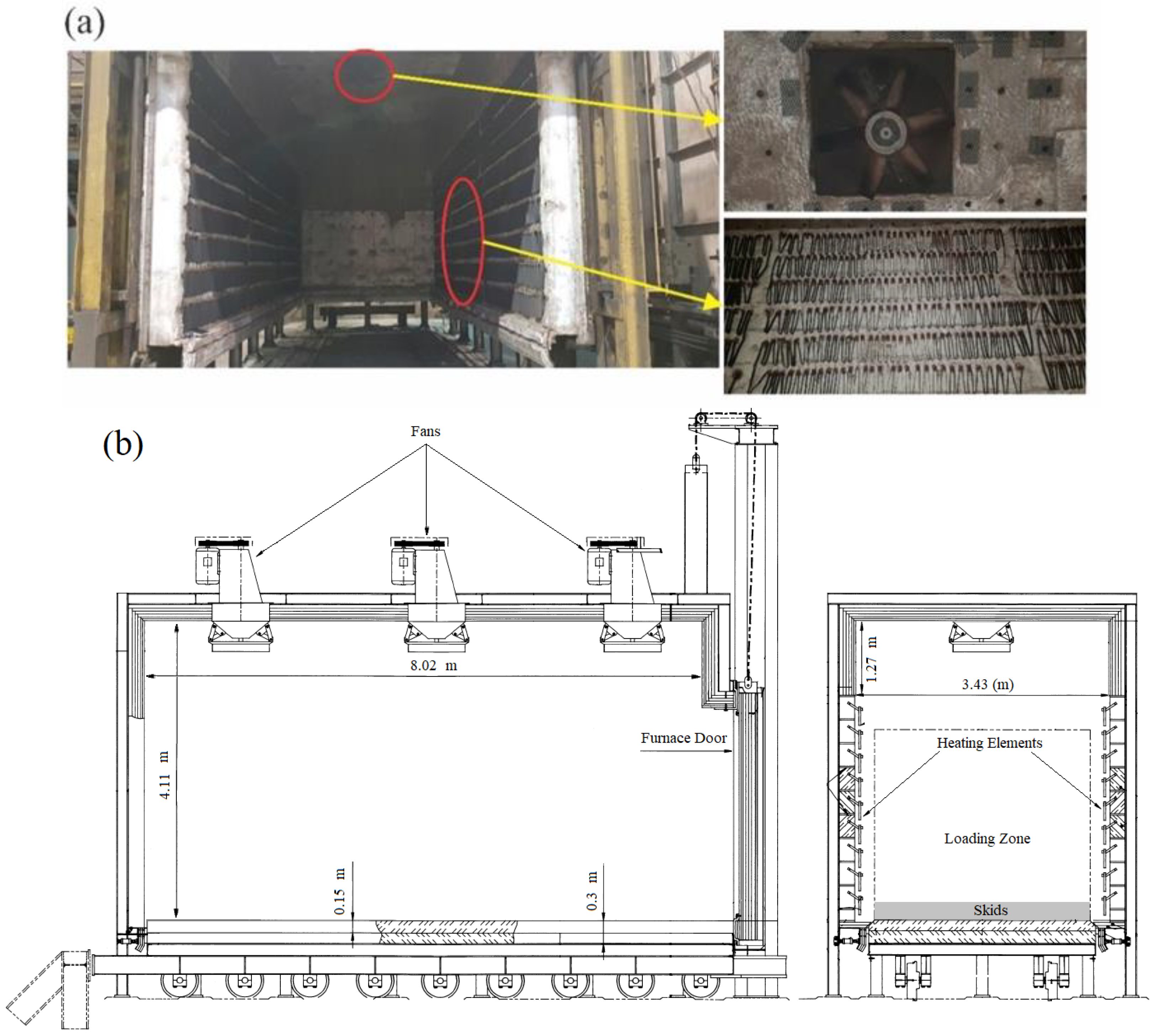





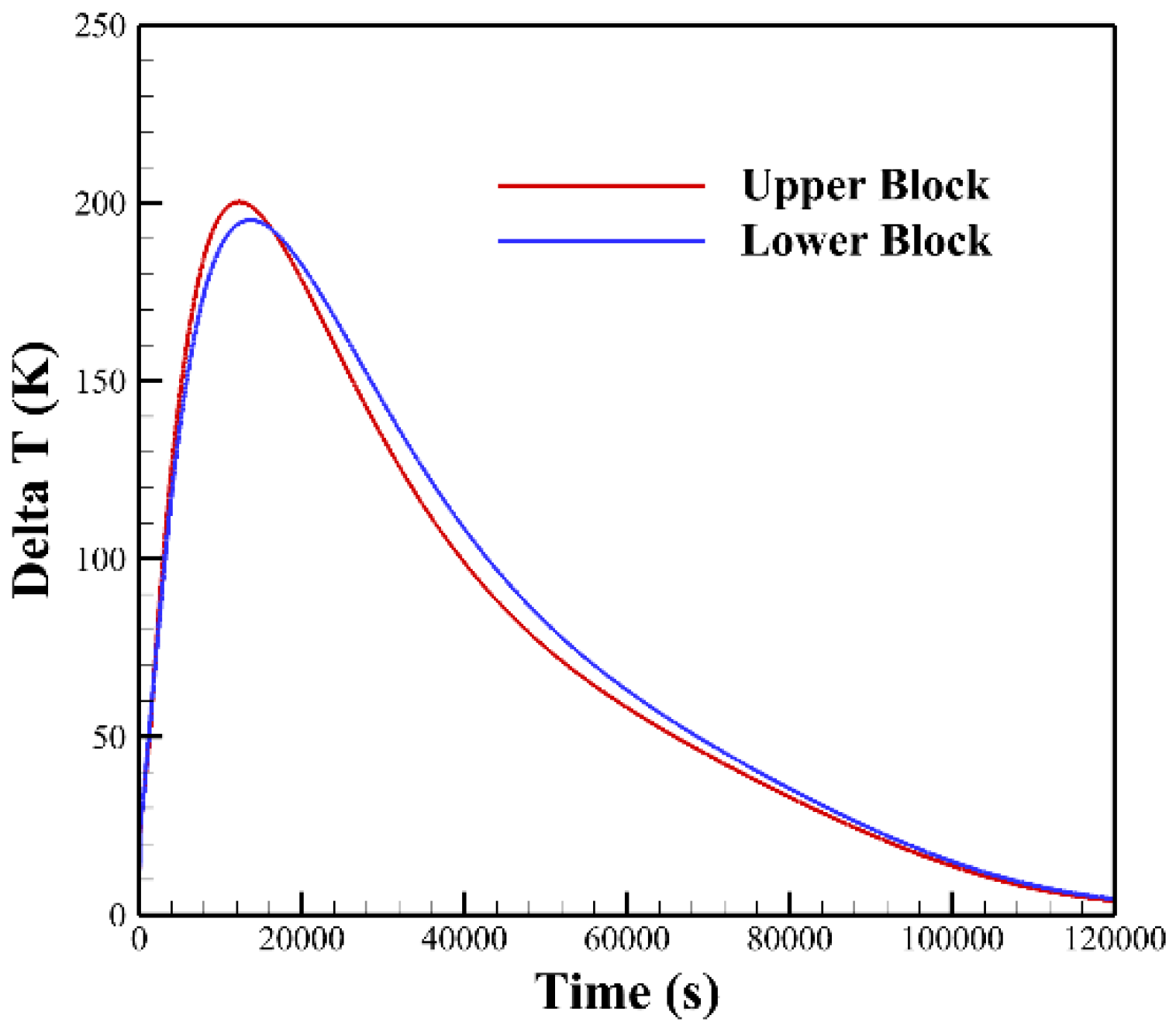

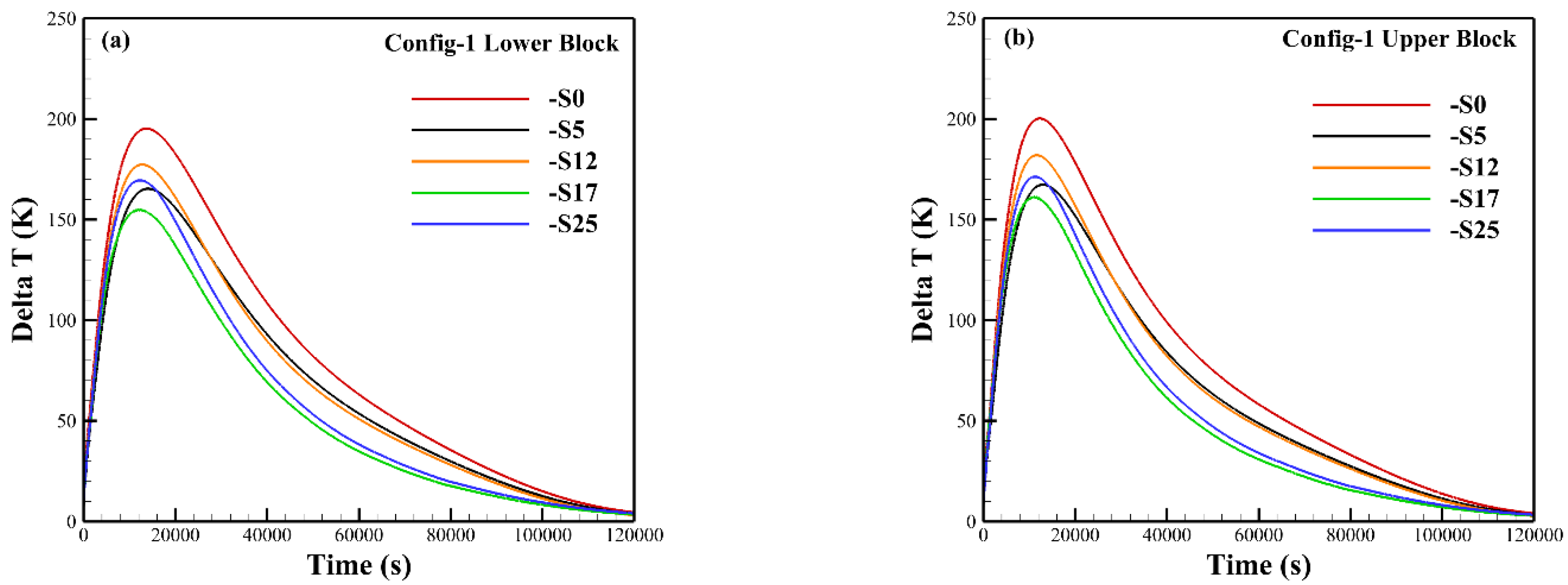

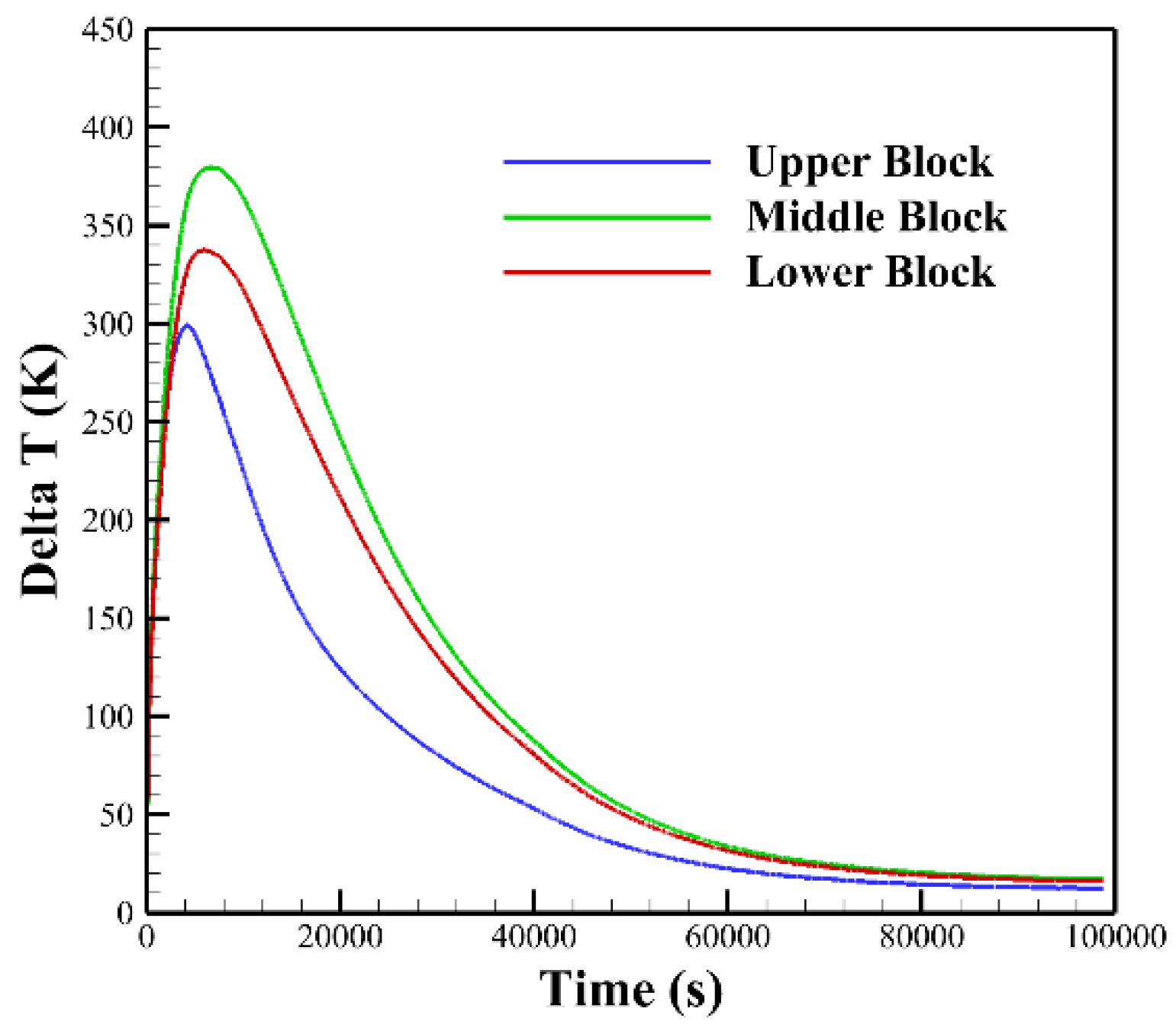

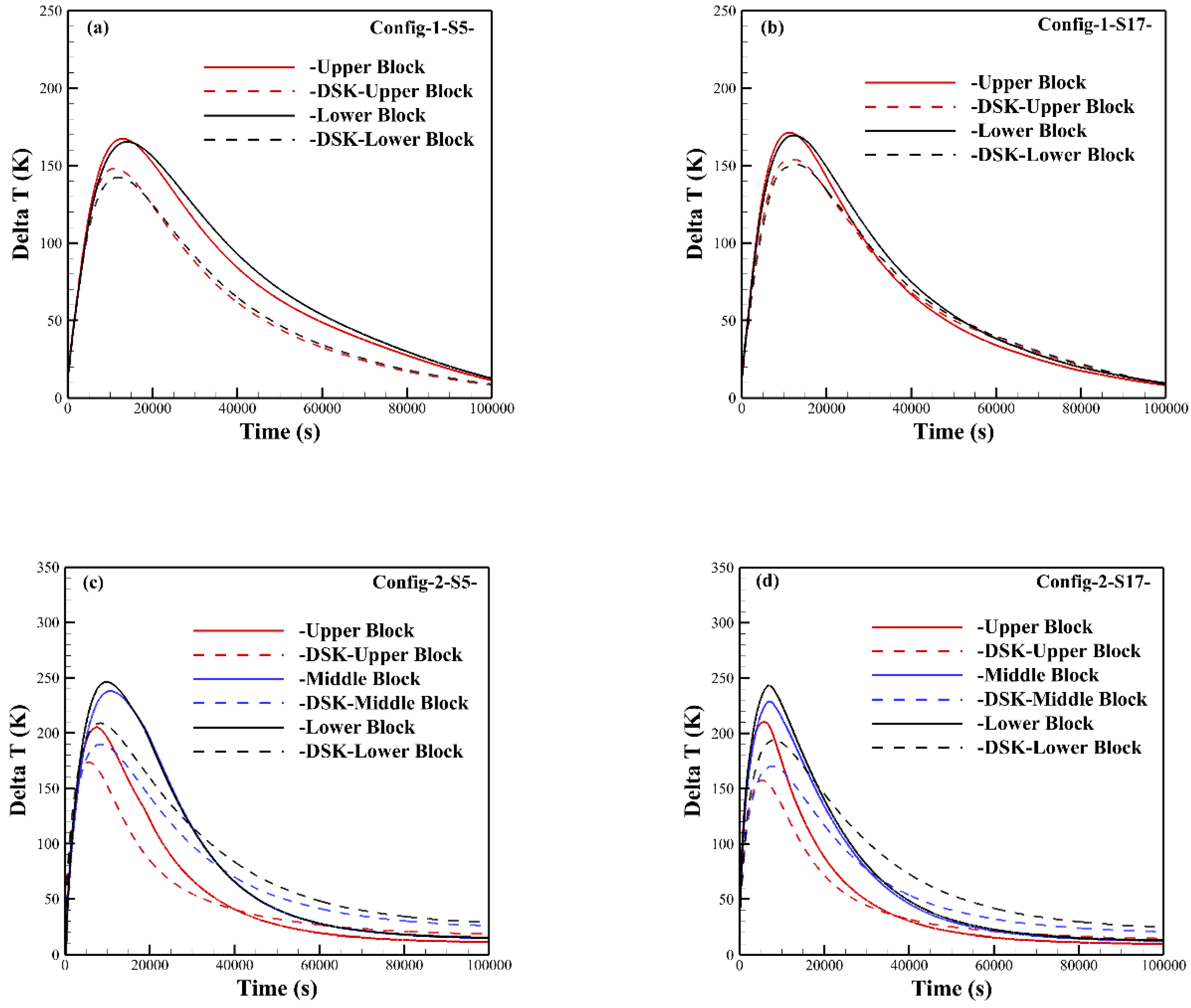
| Products | -S5 | -S12 | -S17 | -S25 |
|---|---|---|---|---|
| Lower Block | 16% | 12% | 26% | 22% |
| Upper Block | 12% | 9% | 23% | 19% |
| Average Effectiveness | 14% | 10.5% | 24.5% | 20.5 |
| Products | -S5 | -S12 | -S17 | -S25 |
|---|---|---|---|---|
| Lower Block | 21% | 17% | 32% | 28% |
| Middle Block | 29% | 27% | 40% | 35% |
| Upper Block | 19% | 17% | 30% | 26% |
| Average Effectiveness | 23% | 20.3% | 34% | 29.6% |
| Products | -S5 | -S5-DSK | -S17 | -S17-DSK |
|---|---|---|---|---|
| Lower Block | 16% | 29% | 26% | 31% |
| Upper Block | 12% | 27% | 23% | 28% |
| Average Effectiveness | 14% | 28% | 24.5% | 29.5% |
| Products | -S5 | -S5-DSK | -S17 | -S17-DSK |
|---|---|---|---|---|
| Lower Block | 21% | 18% | 32% | 28% |
| Middle Block | 29% | 35% | 40% | 45% |
| Upper Block | 19% | 28% | 30% | 37% |
| Average Effectiveness | 23% | 27% | 34% | 36.6% |
Disclaimer/Publisher’s Note: The statements, opinions and data contained in all publications are solely those of the individual author(s) and contributor(s) and not of MDPI and/or the editor(s). MDPI and/or the editor(s) disclaim responsibility for any injury to people or property resulting from any ideas, methods, instructions or products referred to in the content. |
© 2023 by the authors. Licensee MDPI, Basel, Switzerland. This article is an open access article distributed under the terms and conditions of the Creative Commons Attribution (CC BY) license (https://creativecommons.org/licenses/by/4.0/).
Share and Cite
Mirzaei, S.; Bohlooli Arkhazloo, N.; Bazdidi-Tehrani, F.; Morin, J.-B.; Loucif, A.; Jahazi, M. Influence of Spacers and Skid Sizes on Heat Treatment of Large Forgings within an Industrial Electric Furnace. Energies 2023, 16, 2936. https://doi.org/10.3390/en16072936
Mirzaei S, Bohlooli Arkhazloo N, Bazdidi-Tehrani F, Morin J-B, Loucif A, Jahazi M. Influence of Spacers and Skid Sizes on Heat Treatment of Large Forgings within an Industrial Electric Furnace. Energies. 2023; 16(7):2936. https://doi.org/10.3390/en16072936
Chicago/Turabian StyleMirzaei, Sajad, Nima Bohlooli Arkhazloo, Farzad Bazdidi-Tehrani, Jean-Benoit Morin, Abdelhalim Loucif, and Mohammad Jahazi. 2023. "Influence of Spacers and Skid Sizes on Heat Treatment of Large Forgings within an Industrial Electric Furnace" Energies 16, no. 7: 2936. https://doi.org/10.3390/en16072936
APA StyleMirzaei, S., Bohlooli Arkhazloo, N., Bazdidi-Tehrani, F., Morin, J.-B., Loucif, A., & Jahazi, M. (2023). Influence of Spacers and Skid Sizes on Heat Treatment of Large Forgings within an Industrial Electric Furnace. Energies, 16(7), 2936. https://doi.org/10.3390/en16072936








